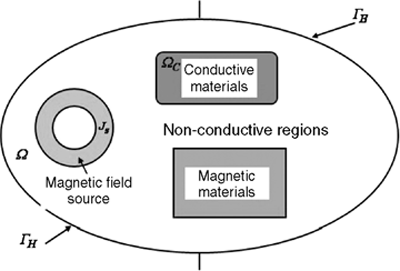1.2. Electromagnetic problem
1.2.1. Local formulation of the electromagnetic problem
Generally speaking, an electromagnetic device can be represented with the help of Figure 1.1.
Figure 1.1. Device configuration

This device consists of non-conductive regions (air or isolating materials), ferromagnetic and/or conductive materials, and sources of magnetic fields (inductor). The whole device forms the domain of study ![]() with boundary
with boundary ![]() .
.
1.2.1.1. Maxwell’s equations
The set of electromagnetic phenomena can be described by six values that depend on the space variable x and time t. They can be written as:
– H: magnetic field (A/m);
– E: electric field (V/m);
– B: magnetic induction (Tesla);
– D: electrical induction (C/m2);
– J: conduction current density (A/m2);
– ![]() : free electric charge density per unit volume (C/m3).
: free electric charge density per unit volume (C/m3).
These different quantities are linked by Maxwell’s equations, which describe the laws of electricity and magnetism in their most general form [DUR 68, FOU 85]:
Ampère’s law:
[1.1]
where represents the displacement current .
Faraday’s law:
[1.2]
Magnetic flux conservation law: ...
Get Electrothermics now with the O’Reilly learning platform.
O’Reilly members experience books, live events, courses curated by job role, and more from O’Reilly and nearly 200 top publishers.

